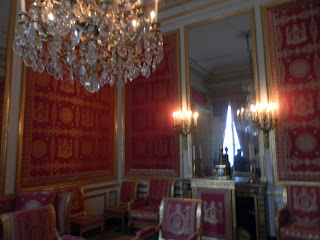Beautiful Fontainebleau
What a splendour!
Fontainebleau is a beautiful palace set
in the Fontainebleau forest.
The setting in the forest, the little
town of Fontainebleau and the palace
make for a magical and enchanting
setting.
Inside the palace are wonderful
treasures and inspiring pieces of art and beauty.
A visit to this magnificent palace of
Fontainebleau is inspirational.
The name Fontainebleau derives from the
legend of a dog named Bleu
who became lost during a hunt in the
forest. This was the king's favourite
hunting dog and the king's men were
sent into the forest to find the dog. Eventually
Bleu was found with a nymph and a stag
at a stream in what must
have been a beautiful setting at the
time. To this day there is a Nymph of
Fontainebleu which can be seen at the
Louvre in Paris. The gates of the palace
were also decorated with a statue of
the Nymph.
I enjoyed reading the book of “The
Serpent and The Moon” by Princess Michael
of Kent as it gave fascinating detail
of earlier times and the story of Diane de Poitiers
and Henri II, the son of Francis I, who
was responsible for building the palace of
Fontainebleau during the renaissance
era. The legend of the nymph of Fontainebleau
is mentioned in this book.
Art and decorative themes from earlier
times are on display.
Furniture and decorations enhance the
rooms, colourful with candles, tapestries, pictures, chandeliers,
mirrors and bedroom furniture. Statues and winged angels are
sometimes depicted in the corners of ceilings and as wall features.
A throne room, queen's apartments,
ballroom (which Francis I had started and which was
completed by Francis I's son, Henri
II), Napoleon's library
and a gallery are impressive and
beautiful.
Looking out from the windows can be
seen views
Resplendent candlelabra atop mirrors
and beside open window frames
evoke an era of romance and elegance of
a by-gone era.
The royal family often lived at this
palace in earlier times as also did Napoleon and Josephine in a later
era. It was sad and poignant to learn that a bedroom had been
beautifully decorated for
Marie Antoinette but the unfortunate
queen never stayed in this room because of the revolution. However,
Josephine in later years stayed in the room. The furnishings were
quite exquisite.
Reds, blues and greens seem to have
been predominant themes in many of the rooms and the green would have
reflected
the Emperor's colours of Napoleon which
were quite beautiful. The style was befitting an Emperor of France
and sufficiently reflected the grandeur of his position.
I can imagine Josephine sitting at her
boudoir in a softening light reflecting on the furrniture writing a
letter or preparing for a grand occasion of music and entertainment
in the ballroom.
The theme of Fontainebleau, a quiet and
serene palace seems quite different from any other
palace.
The palace grounds are peaceful and
beautiful with a water fountain of
Diana, the huntress with her stag and
dogs from which streaming water pours into the fountain.
Looking up at the palace is a balcony
at the side of the palace which I noticed. It is quite unique as it
stands out and I wondered who may have looked out on the gardens from
this balcony. Lovely
Walking back to the main entrance gate
and following the path through the gardens I noticed a sombre
sad looking tree which did have an
unusual name of a hanging tree. This tree seemed to be sad
as though it reflected the troubled
times which the royalty of previous times had endured and
was now no longer there enjoying the
splendours and wonders of beautiful Fontainebleau. This was a most
unusual tree.
In the book of “Louise de la
Valliere” by Alexandre Dumas there is a scene noted where there was
also a Royal Oak at Fontainbleau which was quite a famous tree.
This “venerable oak” was a feature of the park in the time of
Henri II and Diana of Poitiers and Henry IV and Gabrielle d'Estrees.
“...In this manner they reached the
royal oak, the venerable relic of an oak which in its earlier days
had listened to the sighs of Henry II
for the beautiful Diana of Poitiers, and later still to those of
Henry IV for the lovely Gabrielle
d'Estrees.” (page 178 of the Alexandre Dumas novel which has as
a setting the wonderful palace of
Fontainebleau.)
During the time of Louis XIV
Fontainebleau would have been a lively and wonderful place with
entertainments. The park, lake and
gardens would have provided a magical setting.
The book of “Royal Flush” by
Margaret Irwin gives wonderful detail of this era of the court which
gives a fascinating account of the story of Princess Henriette, known
as “Madame” the Duchess of Orleans who married the brother of
Louis XIV.
Katherine de Medici, one time queen of
France, also held magnificent pageants at Fontainebleau and these
entertainments are depicted in a series of tapestries.
Fontainebleau certainly is a historic
place with the surrender of the Germans at the end of the Second
World War being signed in one of the rooms.
Also, the famous staircase from where
Napoleon said good-bye to his soldiers before leaving to go
into exile is a prominent feature.
This staircase is quite magnificent. A poignant reminder of all that
has gone before in this place of memories, pageantry and beauty.












